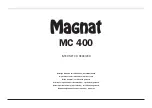
Page 7-8
User and
Installation Guide
G
ROUNDING
AND
W
IRING
THE
S
ATELLITE
A
NTENNA
As with any such installed devices, the satellite antenna and the coaxial cable(s) should be
grounded in accordance with the National Electrical Code (NEC) and local electrical codes
to provide some protection against damage caused by lightning strikes and other electrical
discharges. Even lightning strikes several miles away can generate enough electricity in the
air to damage your system. This section covers general steps you should take to
properly ground both the satellite antenna mast and the cable.
The importance of proper grounding cannot be overemphasized. It will
minimize the potential for damage to your system and maximize safety. How
you ground the system can also affect the performance of the system. This
section is intended as a guideline only. See page A–3 for applicable sections
of the National Electrical Code as of the publication date of this Guide. For
more information, refer to the National Electrical Code and local electrical
codes.
The National Electrical Code and some local electrical codes permit the use of
types of grounding other than those discussed in this Guide. Follow the
National Electrical Code and all local electrical codes. Consult a licensed
electrician or your local electric utility company if you have any questions.
Make sure to locate and avoid underground sewer, gas, water, and telephone
lines before digging. Your local utility companies can tell you where these are
located.
WHAT YOU WILL NEED
l
Copper-clad grounding rod - at least eight feet in length
l
Grounding rod clamp
l
Cable clips - Use weather-resistant, nail-in cable clips to route the coaxial cable.
The clips hold the coaxial cable in place and prevent damage to it. Make sure not
to pinch or puncture the cable.
l
Coaxial cable grounding block
















































